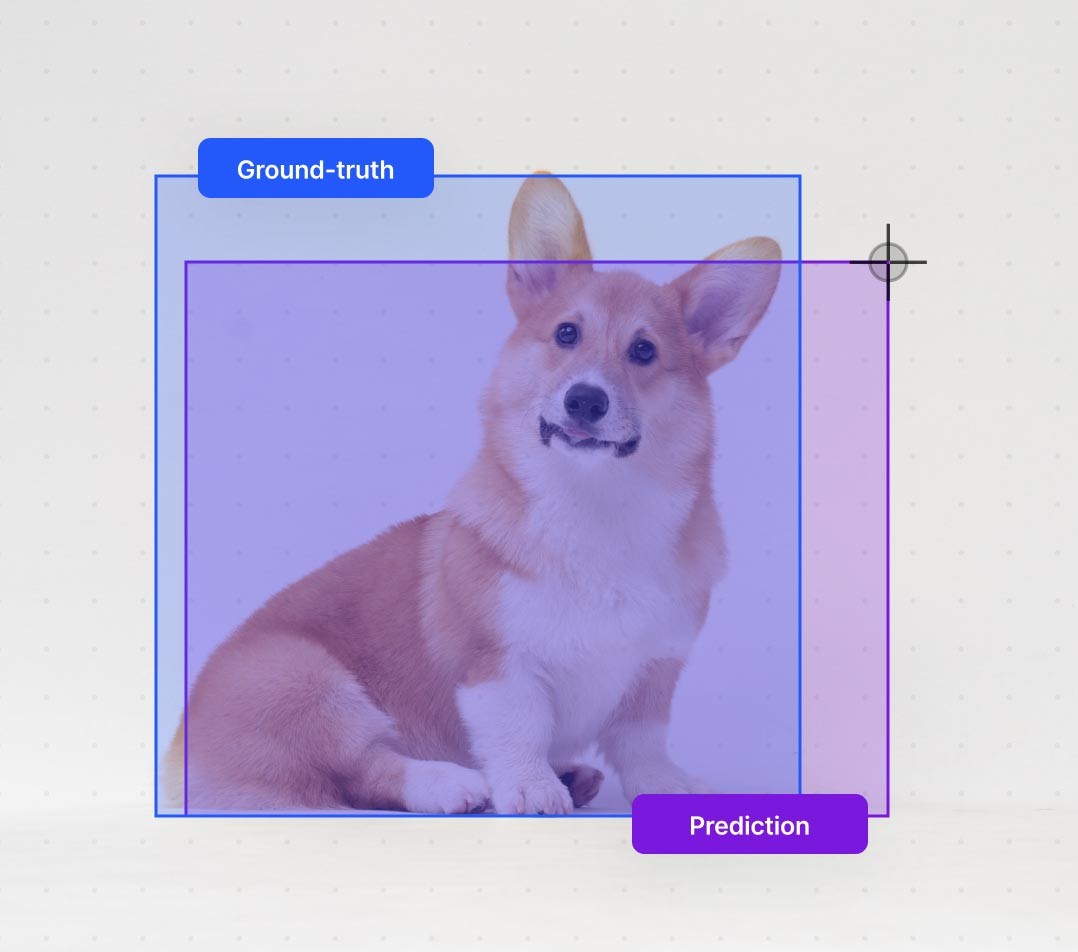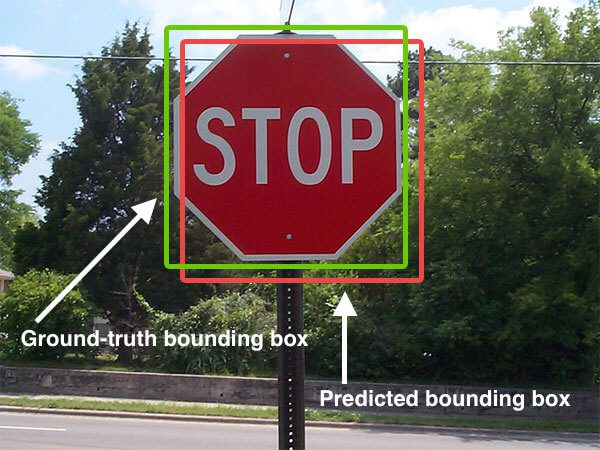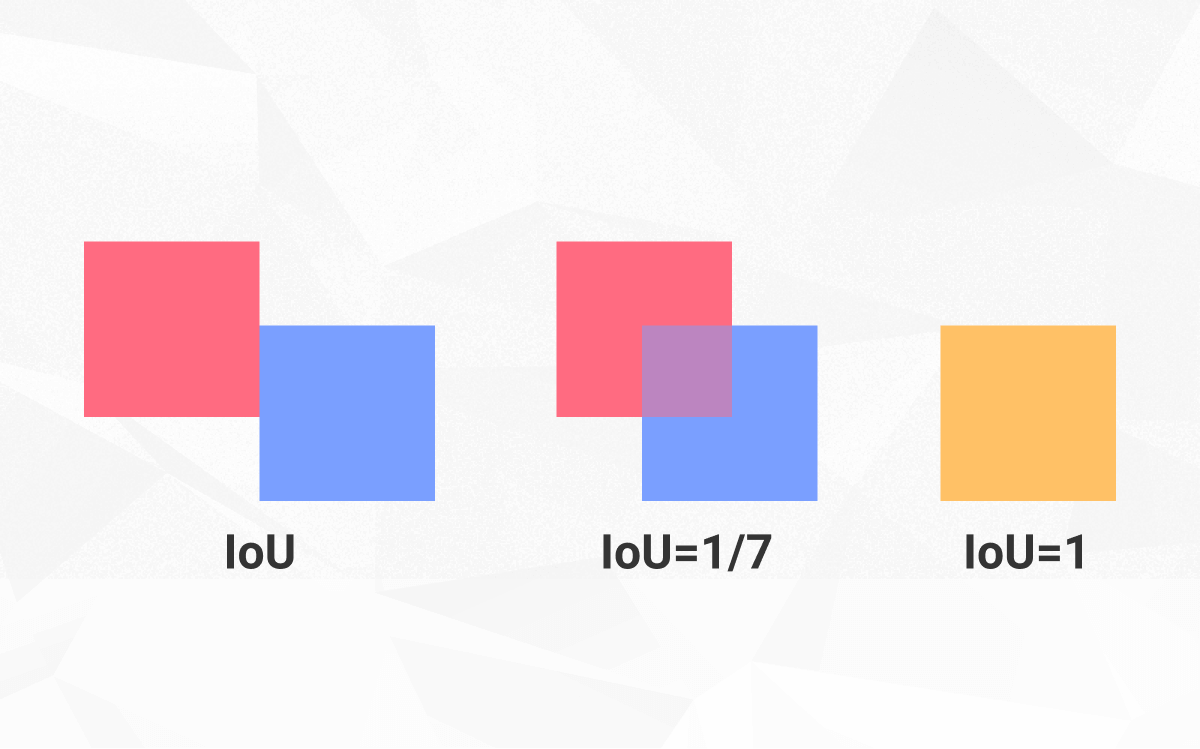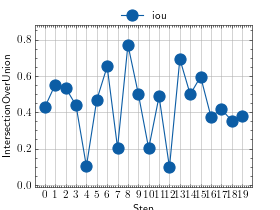In object detection, evaluating the accuracy of your model's predictions is crucial. One widely used metric for this purpose is Intersection over Union (IoU), which quantifies the overlap between the predicted bounding box and the actual object's bounding box. Let's break down how to calculate IoU step-by-step.
Intersection over Union (IoU) is a metric used to evaluate the accuracy of object detectors. It measures how much the predicted bounding box overlaps with the ground truth bounding box.
-
Bounding Boxes: You have two bounding boxes: one represents the ground truth (actual object location) and the other is the prediction from your object detection model.
ground_truth_box = [x1, y1, x2, y2] # Top-left and bottom-right coordinates
predicted_box = [x1, y1, x2, y2] # Top-left and bottom-right coordinates
-
Intersection Area: Calculate the area of overlap between the two boxes.
intersection_x1 = max(ground_truth_box[0], predicted_box[0])
intersection_y1 = max(ground_truth_box[1], predicted_box[1])
intersection_x2 = min(ground_truth_box[2], predicted_box[2])
intersection_y2 = min(ground_truth_box[3], predicted_box[3])
intersection_area = max(0, intersection_x2 - intersection_x1 + 1) *
max(0, intersection_y2 - intersection_y1 + 1)
-
Union Area: Calculate the combined area covered by both boxes.
gt_area = (ground_truth_box[2] - ground_truth_box[0] + 1) *
(ground_truth_box[3] - ground_truth_box[1] + 1)
pred_area = (predicted_box[2] - predicted_box[0] + 1) *
(predicted_box[3] - predicted_box[1] + 1)
union_area = gt_area + pred_area - intersection_area
-
IoU Calculation: Divide the intersection area by the union area.
iou = intersection_area / union_area
The IoU score ranges from 0 to 1, where 0 means no overlap and 1 means perfect overlap. A higher IoU indicates a better prediction.
This Python code defines a function calculate_iou that calculates the Intersection over Union (IoU) between two bounding boxes. It takes two lists as input, representing the ground truth and predicted bounding boxes in the format [x1, y1, x2, y2]. The function calculates the intersection and union areas of the boxes and returns the IoU value, which is a float between 0.0 and 1.0. The code also includes an example usage of the function with two sample bounding boxes and prints the calculated IoU.
def calculate_iou(ground_truth_box, predicted_box):
"""Calculates Intersection over Union (IoU) between two bounding boxes.
Args:
ground_truth_box: A list of 4 integers representing the ground truth box
in the format [x1, y1, x2, y2]
(top-left and bottom-right coordinates).
predicted_box: A list of 4 integers representing the predicted box
in the same format as ground_truth_box.
Returns:
The IoU value, a float between 0.0 and 1.0.
"""
# Calculate intersection area
intersection_x1 = max(ground_truth_box[0], predicted_box[0])
intersection_y1 = max(ground_truth_box[1], predicted_box[1])
intersection_x2 = min(ground_truth_box[2], predicted_box[2])
intersection_y2 = min(ground_truth_box[3], predicted_box[3])
intersection_area = max(0, intersection_x2 - intersection_x1 + 1) * \
max(0, intersection_y2 - intersection_y1 + 1)
# Calculate union area
gt_area = (ground_truth_box[2] - ground_truth_box[0] + 1) * \
(ground_truth_box[3] - ground_truth_box[1] + 1)
pred_area = (predicted_box[2] - predicted_box[0] + 1) * \
(predicted_box[3] - predicted_box[1] + 1)
union_area = gt_area + pred_area - intersection_area
# Calculate IoU
iou = intersection_area / union_area if union_area > 0 else 0.0
return iou
# Example usage:
ground_truth_box = [50, 50, 150, 150]
predicted_box = [75, 75, 160, 160]
iou = calculate_iou(ground_truth_box, predicted_box)
print(f"IoU: {iou:.2f}") Explanation:
-
calculate_iou(ground_truth_box, predicted_box) Function:
- Takes two lists as input, representing the ground truth and predicted bounding boxes.
- Calculates the intersection and union areas as described in the steps above.
- Returns the calculated IoU value.
-
Example Usage:
- Defines example
ground_truth_box and predicted_box coordinates.
- Calls the
calculate_iou function to get the IoU.
- Prints the IoU value formatted to two decimal places.
This code provides a clear and reusable function to calculate the IoU between two bounding boxes, making it easy to incorporate into object detection evaluation pipelines.
Applications:
-
Object Detection Evaluation: IoU is a core metric for comparing the performance of different object detection models.
-
Non-Maximum Suppression (NMS): IoU is used in NMS to filter out overlapping bounding boxes, keeping only the most confident and accurate predictions.
-
Object Tracking: IoU can help track objects across video frames by measuring the overlap between predicted and previous bounding boxes.
Thresholds and Interpretation:
-
Common Thresholds: An IoU threshold (e.g., 0.5 or 0.75) is often used to determine if a prediction is considered a "correct" detection (True Positive) or not.
-
Higher Thresholds: Indicate stricter evaluation, requiring more precise bounding box predictions.
-
Context Matters: The ideal IoU threshold can vary depending on the application and the dataset.
Limitations:
-
Not Sensitive to Small Overlaps: IoU doesn't differentiate well between predictions that have a small overlap but are significantly misaligned.
-
Doesn't Penalize Shape Mismatches: Two bounding boxes with different shapes can have a high IoU if their areas largely overlap.
Alternatives and Extensions:
-
Generalized IoU (GIoU): Addresses the insensitivity to small overlaps by considering the area enclosed by the union and intersection.
-
Distance-IoU (DIoU) and Complete-IoU (CIoU): Further improve on GIoU by incorporating the distance and aspect ratio between bounding boxes.
Key Points to Remember:
- IoU is a simple yet powerful metric for evaluating object detection accuracy.
- Understanding IoU thresholds and limitations is crucial for proper interpretation.
- Explore alternative metrics (GIoU, DIoU, CIoU) for more robust evaluation in certain scenarios.
What is IoU?
IoU (Intersection over Union) is a metric used to evaluate the accuracy of object detectors. It quantifies the overlap between the predicted bounding box and the ground truth bounding box.
How is IoU calculated?
-
Define Bounding Boxes:
-
ground_truth_box = [x1, y1, x2, y2] (Top-left and bottom-right coordinates)
-
predicted_box = [x1, y1, x2, y2] (Top-left and bottom-right coordinates)
-
Calculate Intersection Area: Find the overlapping area between the two boxes.
-
Calculate Union Area: Find the total area covered by both boxes, including the overlap.
-
Calculate IoU: Divide the intersection area by the union area: iou = intersection_area / union_area
Interpretation:
- IoU ranges from 0 to 1.
- 0 indicates no overlap between the boxes.
- 1 indicates perfect overlap, meaning the prediction perfectly matches the ground truth.
- Higher IoU scores indicate more accurate object detection.
IoU is a valuable tool in the object detection toolkit, providing a quantifiable measure of how well a predicted bounding box aligns with the ground truth. By calculating the ratio of intersection and union areas, IoU offers insights into the accuracy of object localization. However, it's crucial to be mindful of its limitations, such as insensitivity to minor overlaps and shape variations. In situations where these factors are critical, exploring alternative metrics like GIoU, DIoU, or CIoU can provide a more comprehensive evaluation. As you delve deeper into object detection, understanding IoU and its nuances will be essential for assessing and refining your models' performance effectively.
-
 Intersection over Union (IoU): Definition, Calculation, Code | Find out how and when to use IoU, one of the most crucial model model assessment metrics.
Intersection over Union (IoU): Definition, Calculation, Code | Find out how and when to use IoU, one of the most crucial model model assessment metrics.
-
 Intersection over Union (IoU) for object detection - PyImageSearch | Discover how to apply the Intersection over Union metric (Python code included) to evaluate custom object detectors.
Intersection over Union (IoU) for object detection - PyImageSearch | Discover how to apply the Intersection over Union metric (Python code included) to evaluate custom object detectors.
-
 Intersection over Union (IoU) for object detection | SuperAnnotate | Intersection over Union (IoU) is a crucial object detection metric. Learn how to estimate model accuracy with IoU for evaluating performance.
Intersection over Union (IoU) for object detection | SuperAnnotate | Intersection over Union (IoU) is a crucial object detection metric. Learn how to estimate model accuracy with IoU for evaluating performance.
-
 Probabilistic Intersection-Over-Union for Training and Evaluation of ... | Oriented object detection is a challenging and relatively new problem. Most existing approaches are based on deep learning and explore Oriented Bounding Boxes (OBBs) to represent the objects. They are typically based on adaptations of traditional detectors that work with Horizontal Bounding Boxes (HBBs), which have been exploring IoU-like loss functions to regress the HBBs. However, extending this idea for OBBs is challenging due to complex formulations or requirement for customized backpropagation implementations. Furthermore, using OBBs presents limitations for irregular or roughly circular objects, since the definition of the ideal OBB is an ambiguous and ill-posed problem. In this work, we jointly tackle the problem of training, representing, and evaluating oriented detectors. We explore Gaussian distributions–called Gaussian Bounding Boxes (GBBs)–as fuzzy representations for oriented objects and propose using a similarity metric between two GBBs based on the Hellinger distance. We show that this metr
Probabilistic Intersection-Over-Union for Training and Evaluation of ... | Oriented object detection is a challenging and relatively new problem. Most existing approaches are based on deep learning and explore Oriented Bounding Boxes (OBBs) to represent the objects. They are typically based on adaptations of traditional detectors that work with Horizontal Bounding Boxes (HBBs), which have been exploring IoU-like loss functions to regress the HBBs. However, extending this idea for OBBs is challenging due to complex formulations or requirement for customized backpropagation implementations. Furthermore, using OBBs presents limitations for irregular or roughly circular objects, since the definition of the ideal OBB is an ambiguous and ill-posed problem. In this work, we jointly tackle the problem of training, representing, and evaluating oriented detectors. We explore Gaussian distributions–called Gaussian Bounding Boxes (GBBs)–as fuzzy representations for oriented objects and propose using a similarity metric between two GBBs based on the Hellinger distance. We show that this metr
-
 Intersection Over Union IoU in Object Detection Segmentation | Intersection Over Union (IoU) is a helper metric for evaluating object detection and segmentation model. Learn from the basics to implementing IoU from scratch.
Intersection Over Union IoU in Object Detection Segmentation | Intersection Over Union (IoU) is a helper metric for evaluating object detection and segmentation model. Learn from the basics to implementing IoU from scratch.
-
 Attention Network for Rail Surface Defect Detection via Consistency ... | Rail surface defect inspection based on machine vision faces challenges against the complex background with interference and severe data imbalance. To meet these challenges, in this article, we regard defect detection as a key-point estimation problem and present the proposed attention neural network for rail surface defect detection via consistency of Intersection-over-Union(IoU)-guided center-point estimation (CCEANN). The CCEANN contains two crucial components. The two components are the stacked attention Hourglass backbone via cross-stage fusion of multiscale features (CSFA-Hourglass) and the CASIoU-guided center-point estimation head module (CASIoU-CEHM). Furthermore, the CASIoU-guided center-point estimation head module integrating the delicate coordinate compensation mechanism regresses detection boxes flexibly to adapt to defects’ large-scale variation, in which the proposed CASIoU loss, a loss regressing the consistency of intersection-over-union (IoU), central-point distance, area ratio, and scale
Attention Network for Rail Surface Defect Detection via Consistency ... | Rail surface defect inspection based on machine vision faces challenges against the complex background with interference and severe data imbalance. To meet these challenges, in this article, we regard defect detection as a key-point estimation problem and present the proposed attention neural network for rail surface defect detection via consistency of Intersection-over-Union(IoU)-guided center-point estimation (CCEANN). The CCEANN contains two crucial components. The two components are the stacked attention Hourglass backbone via cross-stage fusion of multiscale features (CSFA-Hourglass) and the CASIoU-guided center-point estimation head module (CASIoU-CEHM). Furthermore, the CASIoU-guided center-point estimation head module integrating the delicate coordinate compensation mechanism regresses detection boxes flexibly to adapt to defects’ large-scale variation, in which the proposed CASIoU loss, a loss regressing the consistency of intersection-over-union (IoU), central-point distance, area ratio, and scale
-
 What is Intersection over Union (IoU)? | Definition | Encord | Encord | Learn about Intersection over Union (IoU) in object detection tasks of machine learning. Measure the accuracy of predicted vs. ground truth bounding boxes.
What is Intersection over Union (IoU)? | Definition | Encord | Encord | Learn about Intersection over Union (IoU) in object detection tasks of machine learning. Measure the accuracy of predicted vs. ground truth bounding boxes.
-
 Generalized Intersection over Union | Object detection consists of two sub-tasks: localization, which is ... The normalized IoU measure focuses on the area of the shapes, no matter their size.
Generalized Intersection over Union | Object detection consists of two sub-tasks: localization, which is ... The normalized IoU measure focuses on the area of the shapes, no matter their size.
-
 Intersection Over Union (IoU) — PyTorch-Metrics 1.6.2 documentation | boxes ( Tensor ): float tensor of shape (num_boxes, 4) containing num_boxes detection boxes of the format specified in the constructor.
Intersection Over Union (IoU) — PyTorch-Metrics 1.6.2 documentation | boxes ( Tensor ): float tensor of shape (num_boxes, 4) containing num_boxes detection boxes of the format specified in the constructor.









